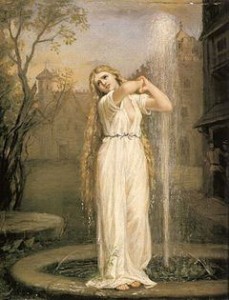
Undine by John William Waterhouse
Considered one of most beautiful of fairytales, Undine is the story of an enchanting water spirit who leaves the underworld in order to obtain a soul.
We first meet Undine as a rambunctious child, drenched from head to toe. She appears suddenly (and eerily) as a sort of “substitute daughter” to a poor fisherman and his wife who are mourning the loss of their own daughter (who tragically slipped into a deep murky body of water).
The reader realizes, right from the get-go, that this beautiful girl on the doorstep is not some average little tyke and they recognize that she carries with her a trace of the underworld (or otherworld).
Written by Freidrich de la Motte Fouqué in 1811 — and influenced by the writings of Paracelsus — Undine falls into the genre of German Romanticism (a new genre for me, to be sure).
This particular tale is new to me, but not unfamiliar as it tells of a captivating water nymph — a mermaid-like creature – escaping her world in order to marry a human which in turn will help her to obtain the unobtainable: a soul. It’s the same struggle that continues to mesmerize readers in the story of The Little Mermaid.
Behind Undine’s fair beauty, however, lies a compelling dark element that nudges our imagination into life’s deeper waters. An uncomfortable nudging, that forces us to ponder soul-less creatures that yearn to be immortal. Nature herself enters the story in the form of air, wind, and of course water, and we pity poor Undine as she seeks to leave one existence in order to belong to another. The latter is more appealing of course as she will receive the ultimate gift: the gift of love from another human being. We feel her connection to both humanity and nature and watch her struggle to escape from an evil underworld king who longs to keep her in her place.
There are so many tender passages in the story of Undine praising nature in all Her splendor while also blending in an invisible realm of fantasy. Perhaps that’s why it has stood the test of time:
You must know, my loved one, that there are beings in the elements which almost appear like mortals, and which rarely allow themselves to become visible to your race. Wonderful salamanders glitter and sport in the flames; lean and malicious gnomes dwell deep within the earth; spirits, belonging to the air, wander through the forests; and a vast family of water spirits live in the lakes and streams and brooks. In resounding domes of crystal, through which the sky looks in with its sun and stars, these latter spirits find their beautiful abode…
Many well-known authors have held a special place in their hearts for the story of Undine.
You may remember Jo March in Louisa May Alcott’s Little Women mentioning the book:
“But I don’t think the little we should spend would do any good. We’ve each got a dollar, and the army wouldn’t be much helped by our giving that. I agree not to expect anything from Mother or you, but I do want to buy UNDINE AND SINTRAM for myself. I’ve wanted it so long,” said Jo, who was a bookworm.
Also, as an Edith Wharton enthusiast, I’d be remiss if I did not mention Undine Spragg in Wharton’s wonderful The Custom of the Country. Undine Spragg has the physical beauty of a mythical undine, but her sights are set on claiming riches rather than souls. This, unfortunately, is to Ralph Marvel’s detriment as he views this social-climbing undine through rose-colored glasses and marries her. Sadly, she not only claims his heart and finances…but also claims (and destroys) his life…body and soul.
The story of Undine will likely have other incarnations in the future and will continue to call us — like the lovely siren — to enter into new literary-fantasy worlds.
